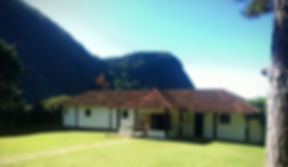
In the lands of Santa Cruz
A monastery founded for the greater glory of God, faithful to doctrine, and combatting error is a powerful sign of His Grace. The Holy Cross Monastery is a sign of God's merciful grace and love for His faithful, who had trusted God's providence.
On May 3, 1987, the Santa Cruz Monastery was founded, in Nova Friburgo, RJ, on a magnificent land donated by one of the first Brazilian benefactors. In an admirable gesture, the donation initially encompassed a farm in Janela das Andorinhas, later expanding with the help of many others committed to its growth. Without the precious help of Archbishop Marcel Lefebvre, Dom Gérard Calvet, and Bishop Castro Mayer, who contributed mainly to the monastery, it would probably not have prospered.
The original monks were six in number, having been sent from France and having as Prior a Brazilian religious who had entered Bédoin in 1974, Dom Tomás de Aquino Ferreira da Costa. Influenced by the monasteries of Europe and harmonized with Brazilian culture, the monks put every detail of the work in place. Stones cut from the same region of the farm; Tiles chosen and purchased. A great effort is undertaken with zeal, as the Scripture says, "Zelo zelatus sum pro Domino Deo exercituum" (I Kings, XIX, 10), "I consume myself with zeal for the Lord God of Armies."
In May of 1987, Bishop Castro Mayer officiated over the Solemn Blessing of the Chapel and its two bells. Countless visitors from different regions of Brazil and the world came, especially the SSPX priests from Campos and monks from the Monastery of Le Barroux.

We adhere wholeheartedly and with all our soul to Catholic Rome, guardian of the Catholic faith and the traditions necessary for the maintenance of that faith, to eternal Rome, teacher of wisdom and truth.
On the contrary, we refuse and have always refused to follow the Rome of neo-modernist and neo-Protestant tendency that clearly manifested itself in the Second Vatican Council, and after the Council in all the reforms that emerged from it."
D. Lefebvre - Declaration of 1974
On the side, one of the letters addressed by D. Marcel Lefebvre to D. Tomás de Aquino
In 1988, however, Dom Gérard made a painful decision for the developing community: Dom Gérard signed an agreement with Rome and, consequently, took the community in a new direction at the expense of the Faith. In the time of Arianism, a sign of orthodoxy was to be in communion with St. Athanasius; in the same way, we united ourselves with Archbishop Marcel Lefebvre and Bishop Castro Mayer, Bishops faithful to the Tradition of the Church even before the Second Vatican Council.
Despite the inevitable difficulties and with the generous spiritual and material support from all parts of Brazil and Europe, the Monastery of Santa Cruz decided to separate from Dom Gérard. Despite such difficulties, the Monastery grew as God provided many vocations. Since then, Catholic Tradition, in Brazil and throughout the world, has seen many foundations, affiliated or not with the Monastery, fail for many reasons, good or bad, reasons which only God can judge. However, after thirty years since its foundation, Divine Providence continues to provide for the faithful. The Holy Sacrifice of the Mass and the spreading of the Gospel continue.
The battle continued as the SSPX leadership proceeded with its dangerous program of rapprochement with Modernist Rome. In response, Bishop Richard Williamson, one of the four bishops consecrated by Archbishop Marcel Lefebvre and Bishop Castro Mayer, had no alternative but to elevate three resistance priests to the episcopate. Fr. Michel Faure, Fr. Gerardo Zendejas, and our Prior, Dom Tomás de Aquino, under the motto "Veritatem dilexisti," accepted the task. The newly consecrated Bishops will continue the work started by the Apostles and faithfully continued by Archbishop Marcel Lefebvre and Bishop Castro Mayer, bringing comfort and hope to the faithful to propagate the Faith and guard the Sacred Deposit.
